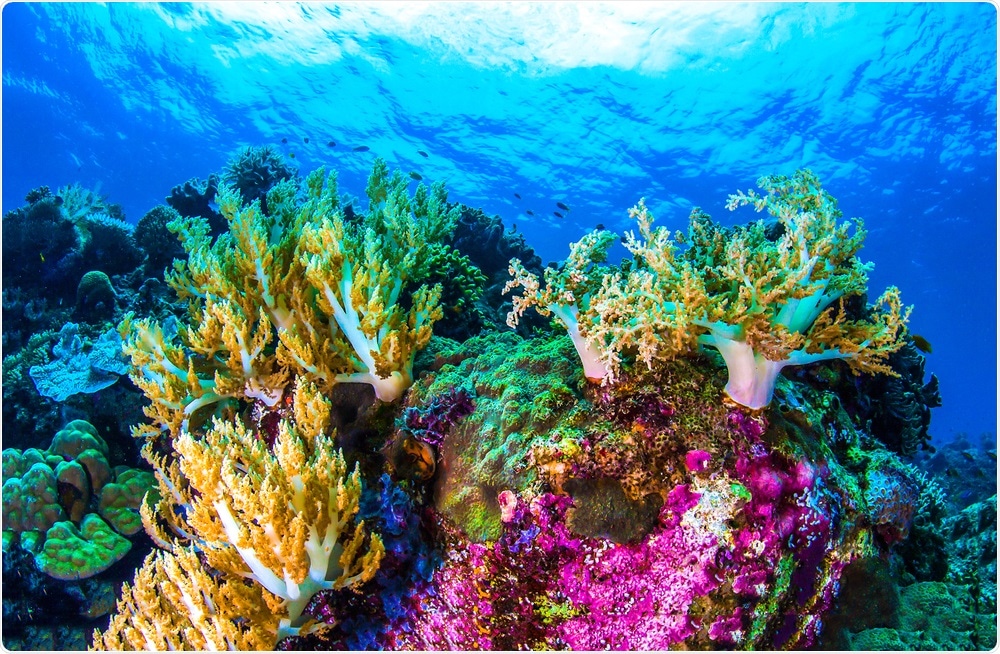Researchers at the University of Seville Marine Biology Laboratory, working in the research team of Dr. José Carlos García Gómez, have demonstrated the usefulness of using the SBPQ (Sessile Bioindicators Permanent Quadrats) methodology to detect potential shifts in coastal areas.

Image Credit: Irina Markova/Shutterstock.com
This technique acts a warning of incidents of a local nature, such as water pollution from poorly treated urban wastewater discharges; or of a more global nature, which become evident by monitoring climate change through species that are sensitive to temperature increases; or incidents caused by the intrusion of potentially invasive species.
The first step in applying the SBPQ methodology is to select areas where sensitive native species are present and live in their adult form attached to the rocks (sessile), such as corals and sponges. These species have been unable to escape or relocate if environmental conditions deteriorate, meaning they can be used as environmental sentinels.
To do this, the evolution over time of their presence in specific enclaves is monitored closely so that it is possible to detect changing circumstances if they begin to disappear. This early detection of environmental impacts in the coastal environment enables researchers to locate the source of the impact and, potentially, to correct it swiftly when the first signs of change are observed.
These conclusions flow from data collected over a ten year period (2005-2014), making this study one of the longest in the field of pre-coral and coral reefs. Long-term series are key to establishing trends and solving many unanswered questions around developments in ecosystems and possible changes to them.
The study, published in the scientific journal PloS One, sought to confirm the validity and usefulness of the SBPQ methodology by focusing on a ten-year historical series which it was designed to test.
Furthermore, the researchers were able to confirm the hypothesis that is very stable and biostructured, high diversity beds, coral reef communities are very stable and tend not to vary over time unless disturbed by environmental factors that change the system.
For ten years no change was recorded in the presence/absence of the monitored indicator species or in their abundances on the monitored fixed surfaces, meaning that, in that period of time no change--at least no change of significance--occurred leading to lethal or maladaptive effects on selected sensitive organisms in native biota.
Further research, also using the SBPQ method, led to the detection in 2015 of the invasive Asian algae Rugulopteryx okamurae (although not yet formally declared as such) in the Strait of Gibraltar. Its presence was detected for the first time in the area associated with pre-coral enclaves of high stability, spatial structure, and associated biodiversity, which are very sensitive to environmental changes in the system.
In this case, researchers from the University of Seville Marine Biology Laboratory tentatively linked this shift to global warming, since the invasion of the species occurred in 2015, coinciding with the highest peak in surface water temperature on the Andalusian coast in the period between 2000 and 2017. These considerations were reflected in another recent article by the team led by Dr. García Gómez, published in the scientific journal Science of The Total Environment (STOTEN).
The Strait of Gibraltar is an especially interesting area to test the usefulness of the SBPQ methodology as it presents coral habitats in pristine waters, especially in the Estrecho Natural Park, featuring excellent indicator species which are highly sensitive to environmental changes.
Based on the results obtained, the researchers underscored the importance of promoting a network to monitor environmental impacts in the coastal environment, tracking invasive species, and monitoring global warming in the western Mediterranean.
But perhaps the most important thing about the SBPQ methodology is that it is a tool for social participation that reaches out to diving clubs and centers who want to get involved, under scientific supervision, in the underwater environment to monitor our coastal ecosystems,"
Professor José Carlos García Gómez, University of Seville Marine Biology Laboratory
"It is a tool that aims to fit into the recent world trend of Citizen Science, which has shown engagement with the conservation of underwater nature".
It is a promising line of research developed by the University of Seville to transfer research results and social innovation in the field of marine biology.